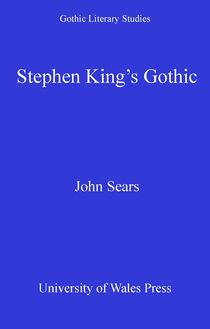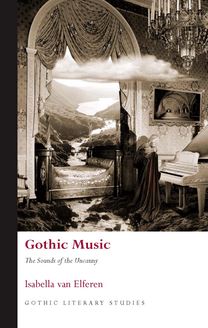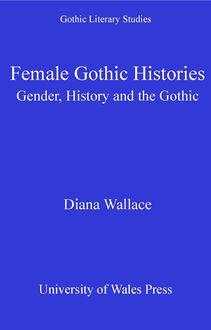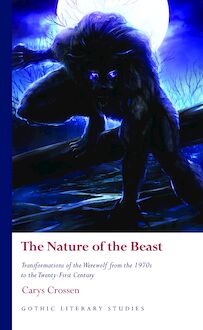-
 Univers
Univers
-
 Ebooks
Ebooks
-
 Livres audio
Livres audio
-
 Presse
Presse
-
 Podcasts
Podcasts
-
 BD
BD
-
 Documents
Documents
-
- Cours
- Révisions
- Ressources pédagogiques
- Sciences de l’éducation
- Manuels scolaires
- Langues
- Travaux de classe
- Annales de BEP
- Etudes supérieures
- Maternelle et primaire
- Fiches de lecture
- Orientation scolaire
- Méthodologie
- Corrigés de devoir
- Annales d’examens et concours
- Annales du bac
- Annales du brevet
- Rapports de stage
La lecture à portée de main
Découvre YouScribe en t'inscrivant gratuitement
Je m'inscrisAmerican Gothic Art and Architecture in the Age of Romantic Literature , livre ebook
Découvre YouScribe en t'inscrivant gratuitement
Je m'inscrisEn savoir plus
En savoir plus

Description
Contents
Introduction
Chapter One. Gothic Monticello: Thomas Jefferson’s Garden Narratives
Chapter Two. ‘Banditti Mania’: The Gothic Haunting of Washington Allston
Chapter Three. ‘Arranging the Trap Doors’: The Gothic Revival Castles of Alexander Jackson Davis
Chapter Four. Old Dwellings Transmogrified: The Homes of James Fenimore Cooper and Washington Irving
Chapter Five. Gothic Castles in the Landscape: Thomas Cole, Sir Walter Scott And the Hudson River School of Painting
Chapter Six. The Theatrical Spectacle of Medieval Revival: Edwin Forrest’s Fonthill Castle
Conclusion. ‘Clap It Into a Romance:’ Nathaniel Hawthorne’s Gothic Houses
Sujets
Informations
| Publié par | University of Wales Press |
| Date de parution | 15 novembre 2014 |
| Nombre de lectures | 0 |
| EAN13 | 9781783161614 |
| Langue | English |
| Poids de l'ouvrage | 6 Mo |
Informations légales : prix de location à la page 0,2174€. Cette information est donnée uniquement à titre indicatif conformément à la législation en vigueur.
Extrait
AMERICAN GOTHIC ART AND ARCHITECTURE
IN THE AGE OF ROMANTIC LITERATURESERIES PREFACE
Gothic Literary Studies is dedicated to publishing groundbreaking
scholarship on Gothic in literature and film. The Gothic, which has
been subjected to a variety of critical and theoretical approaches,
is a form which plays an important role in our understanding of
literary, intellectual and cultural histories. The series seeks to promote
challenging and innovative approaches to Gothic which question
any aspect of the Gothic tradition or perceived critical orthodoxy.
Volumes in the series explore how issues such as gender, religion,
nation and sexuality have shaped our view of the Gothic tradition.
Both academically rigorous and informed by the latest developments
in critical theory, the series provides an important focus for scholarly
developments in Gothic studies, literary studies, cultural studies and
critical theory. The series will be of interest to students of all levels
and to scholars and teachers of the Gothic and literary and cultural
histories.
SERIES EDITORS
Andrew Smith, University of Sheffield
Benjamin F. Fisher, University of Mississippi
EDITORIAL BOARD
Kent Ljungquist, Worcester Polytechnic Institute Massachusetts
Richard Fusco, St Joseph’s University, Philadelphia
David Punter, University of Bristol
Chris Baldick, University of London
Angela Wright, University of Sheffield
Jerrold E. Hogle, University of ArizonaAmerican Gothic Art and
Architecture in the Age of
Romantic Literature
Kerry Dean Carso
UNIVERSITY OF WALES PRESS
CARDIFF
2014© Kerry Dean Carso, 2014
All rights reserved. No part of this book may be reproduced in any material
form (including photocopying or storing it in any medium by electronic
means and whether or not transiently or incidentally to some other use of
this publication) without the written permission of the copyright owner.
Applications for the copyright owner’s written permission to reproduce
any part of this publication should be addressed to the University of Wales
Press, 10 Columbus Walk, Brigantine Place, Cardiff CF10 4UP.
www.uwp.co.uk
British Library Cataloguing-in-Publication Data
A catalogue record for this book is available from the British Library.
ISBN 978-1-78316-160-7
e-ISBN 978-1-78316-161-4
The right of Kerry Dean Carso to be identified as author of her contribution
has been asserted in accordance with sections 77 and 79 of the Copyright,
Designs and Patents Act 1988.
Typeset in Wales by Eira Fenn Gaunt, Cardiff
Printed by CPI Antony Rowe, Chippenham, WiltshireDedicated to
Brian, Owen and Nathaniel
and to the memory of
Teddy Dean CarsoCONTENTS
Acknowledgements ix
List of illustrations xiii
Introduction 1
1 Gothic Monticello: Thomas Jefferson’s Garden Narratives 9
2 ‘Banditti Mania’: The Gothic Haunting of Washington
Allston 29
3 ‘Arranging the Trap Doors’: The Gothic Revival Castles
of Alexander Jackson Davis 51
4 Old Dwellings Transmogrified: The Homes of
James Fenimore Cooper and Washington Irving 69
5 Gothic Castles in the Landscape: Thomas Cole, Sir Walter
Scott and the Hudson River School of Painting 95
6 The Theatrical Spectacle of Medieval Revival: Edwin
Forrest’s Fonthill Castle 115
Conclusion ‘Clap It Into a Romance’: Nathaniel Hawthorne’s
Gothic Houses 145
Notes 161
Bibliography 209
Index 235ACKNOWLEDGEMENTS
My greatest intellectual debt is to my graduate school advisor and
mentor, Keith Morgan, of Boston University. Over the years, Keith
has been very supportive of my work. This book began as a
dissertation, and I would like to thank my dissertation committee: Keith
Morgan, Patricia Hills, Adam Sweeting, Eliza Richards and Naomi
Miller. All of them have assisted me in innumerable ways. Pat and
Naomi have been especially helpful as mentors. I am grateful to
William Vance, Professor Emeritus of English at Boston University,
for introducing me to Washington Allston’s Lectures on Art and Monaldi
during my preparation for my comprehensive exam. Thank you to
Bruce Schulman for his encouragement and to the Boston University
Humanities Foundation for awarding me a dissertation grant in
2000.
My fascination with the Gothic began during my junior tutorial
in the English Department at Harvard University. I would like to
thank my junior tutor Carolyn Dever for introducing me to the
thrill of reading Gothic novels and my thesis adviser Cheryl Nixon
for help ing me to articulate connections between Gothic literature
and architectural space. I doubt that Carolyn and Cheryl realized
at the time how much they stimulated my intellectual interest in
this subject.
Of course, this book would not have been possible without the
work of scholars who have come before me. I owe a debt to the
authors of the many books and articles I consulted on Gothic Revival
architecture, Romantic paintings and Gothic literature. Particularly
useful were Janice Gayle Schimmelman’s dissertation at the University
of Michigan, Patrick Snadon’s dissertation at Cornell University,
Donald Ringe’s work on American Gothic literature and John
Zukowsky’s research on the Hudson River Gothic Revival. Acknowledgements
I am grateful to the staffs of the many libraries where I have
conducted research, including the Albany Institute of History and Art;
the Avery Architectural and Fine Arts Library at Columbia University;
the International Center for Jefferson Studies at Monticello; the
Newington-Cropsey Foundation; the New York Public Library; the
New-York Historical Society; the Metropolitan Museum of Art;
the Maryland Historical Society; the University of Pennsylvania’s
Rare Book and Manuscript Library; the Harvard Theatre Collection;
the Massachusetts Historical Society; the Longfellow National
Historic Site; the Princeton University Library; the American
Antiquarian Society; and the New York State Historical Association.
Sister Christine Murphy, the archivist at the College of Mount Saint
Vincent in Riverdale, New York, was helpful to me on more than
one occasion. I would like to thank Hugh MacDougall of the James
Fenimore Cooper Society for sharing his research and expertise on
Cooper with me.
Portions of this book appeared previously and have been revised:
chapter 2 first appeared as ‘Banditti Mania: The Gothic Haunting
of Washington Allston’, Symbiosis: A Journal of Anglo-American Literary
Relations, 11, 1 (April 2007), 105–30; chapter 3 as ‘Diagnosing the
“Sir Walter Disease”: American Architecture in the Age of Romantic
Literature’, Mosaic: A Journal for the Interdisciplinary Study of Literature,
35, 4 (December 2002), 122–42; chapter 4 as ‘“To Loiter about the
Ruined Castle”: Washington Irving’s Gothic Inspiration’, The
Hudson River Valley Review, 24, 2 (spring 2008), 22–41 and ‘The
Old Dwelling Transmogrified: James Fenimore Cooper’s Otsego
Hall’, in Hugh MacDougall (ed.), James Fenimore Cooper: His Country
& His Art (Papers from the 2001 Cooper Seminar, No. 13) (Oneonta,
NY: State University of New York College at Oneonta, 2002),
pp. 26–35; chapter 5 as ‘Gothic Castles in the Landscape: Sir Walter
Scott and the Hudson River School’, Gothic Studies, 14, 2 (November,
2012), 1–22; and chapter 6 as ‘The Theatrical Spectacle of Medieval
Revival: Edwin Forrest’s Fonthill Castle’, Winterthur Portfolio: A
Journal of American Material Culture, 39, 1 (spring 2004), 21–41.
My friends George and Nancy Madison played a role in the final
stages of my research. They hosted my husband and me in Florence,
Italy, for a week and took us to see the Villa Montauto where
Hawthorne lived in 1858. Thank you, George and Nancy, for a splendid
xAcknowledgements
morning on the Bellosguardo Hill. In 2013, Theresa Flanigan hosted
me in Florence, allowing me a second visit to the villa. Theresa has
been unflagging in her support over the years, and I am grateful for
her friendship. Rachel Dressler has also acted as a sounding board
for my ideas, and her expertise as a medievalist and neo-medievalist
has been extremely helpful.
I want to thank my graduate school colleagues at Boston University,
especially my friends Laura Kay, Laura Driemeyer, Elysa Engelman,
Laura Johnson, Stacey McCarroll Cutshaw, Thomas Denenberg,
David Brody and Cheryl Boots, as well as my good friend Jane
Marsh Manzi whom I first met at Radcliffe College in 1992. In
2002–3, I taught at James Madison University in Harrisonburg,
Virginia, where I had the privilege of working with wonderful
people, including Kay Arthur, David Ehrenpreis, Diane Ehrenpreis,
Karen Gerard and Rachel Malcolm Ensor. I especially want to
thank Diane for encouraging me to apply for a Batten fellowship
at the International Center for Jefferson Studies at Monticello,
where I spent a month doing research in 2003. Thank you to the
scholars and staff of the ICJS for their assistance, especially William
Beiswanger.
My colleagues at the State University of New York at New Paltz
have been very supportive, as have all of my students over the years.
Thank you to my art history colleagues Elizabeth Brotherton, Keely
Heuer, Jaclynne Kerner, Ellen Konowitz, William Rhoads, Susan
DeMaio Smutny, Beth Wilson and Reva Wolf, and thank you to
Andrea Varga of the Theatre Arts Department. Susan assisted me
with some of the illustrations for this book, and I am very grateful
to her. Thank you to Laura Silvernail for administrative support.
The Dean’s Office of the School of Fine and Performing Arts and
the Art History Department at SUNY New Paltz contributed
financial support for the rights and reproductions of this book’s
illustrations. The Dr. Nuala McGann Drescher Leave Award from
the United University Professions in 2010 and a sabbatical from
SUNY New Paltz in 2013–14 allowed me to complete this book.
I want to thank the Gothic Literary Studies series editors, Andrew
Smith and Benjamin F. Fisher, and the editors and staff of University
of Wales Press, especially Sarah Lewis, Si
-
 Univers
Univers
-
 Ebooks
Ebooks
-
 Livres audio
Livres audio
-
 Presse
Presse
-
 Podcasts
Podcasts
-
 BD
BD
-
 Documents
Documents
-
Jeunesse
-
Littérature
-
Ressources professionnelles
-
Santé et bien-être
-
Savoirs
-
Education
-
Loisirs et hobbies
-
Art, musique et cinéma
-
Actualité et débat de société
-
Jeunesse
-
Littérature
-
Ressources professionnelles
-
Santé et bien-être
-
Savoirs
-
Education
-
Loisirs et hobbies
-
Art, musique et cinéma
-
Actualité et débat de société
-
Actualités
-
Lifestyle
-
Presse jeunesse
-
Presse professionnelle
-
Pratique
-
Presse sportive
-
Presse internationale
-
Culture & Médias
-
Action et Aventures
-
Science-fiction et Fantasy
-
Société
-
Jeunesse
-
Littérature
-
Ressources professionnelles
-
Santé et bien-être
-
Savoirs
-
Education
-
Loisirs et hobbies
-
Art, musique et cinéma
-
Actualité et débat de société
- Cours
- Révisions
- Ressources pédagogiques
- Sciences de l’éducation
- Manuels scolaires
- Langues
- Travaux de classe
- Annales de BEP
- Etudes supérieures
- Maternelle et primaire
- Fiches de lecture
- Orientation scolaire
- Méthodologie
- Corrigés de devoir
- Annales d’examens et concours
- Annales du bac
- Annales du brevet
- Rapports de stage




















